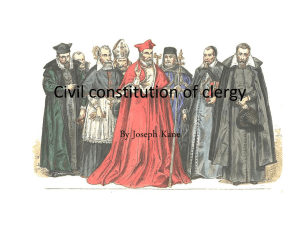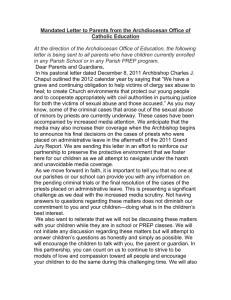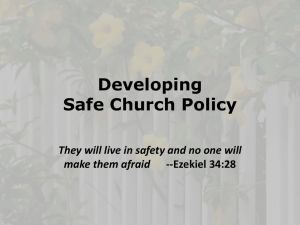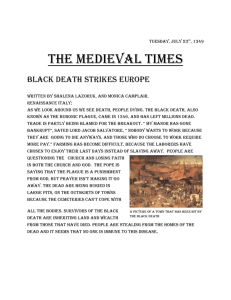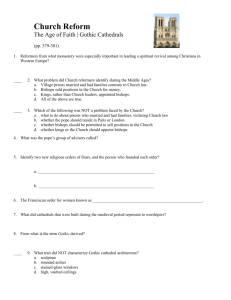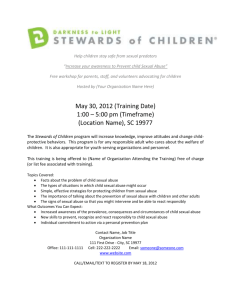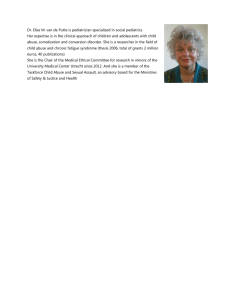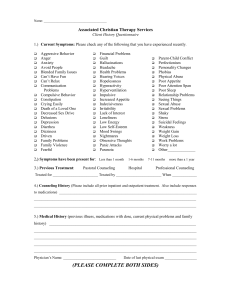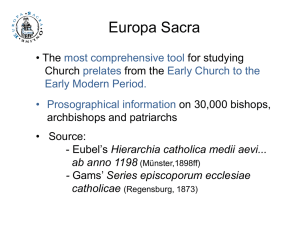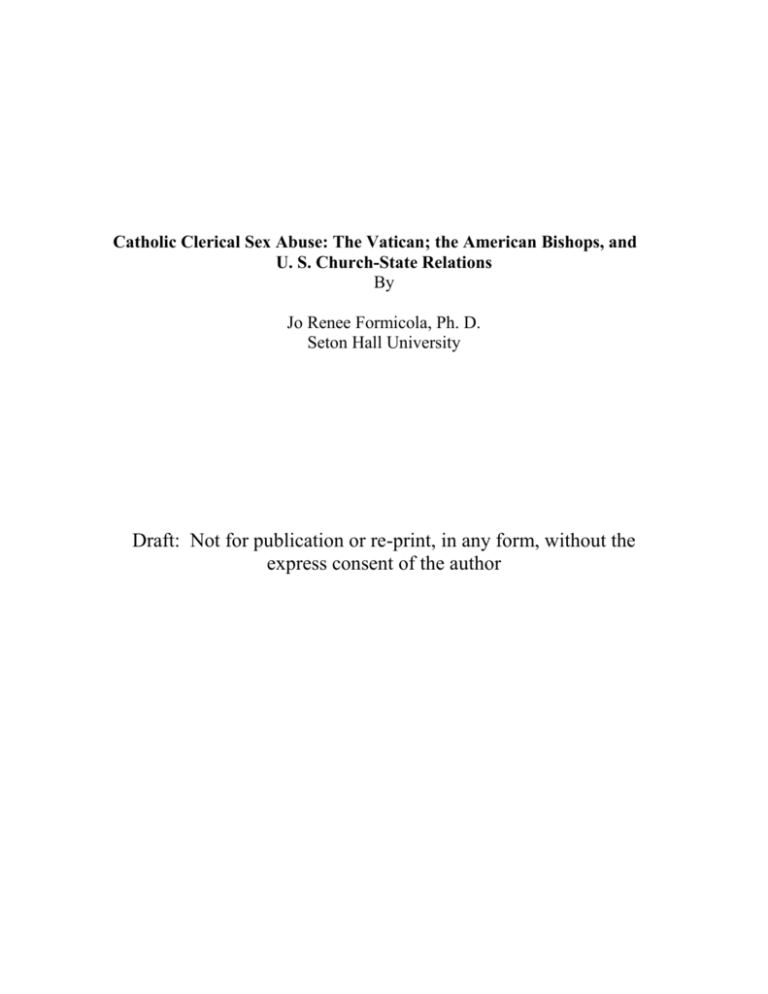
Catholic Clerical Sex Abuse: The Vatican; the American Bishops, and
U. S. Church-State Relations
By
Jo Renee Formicola, Ph. D.
Seton Hall University
Draft: Not for publication or re-print, in any form, without the
express consent of the author
2
I.
Introduction
Pope John Paul II has termed clerical sexual abuse as both a grave sin and a
crime.1 Speaking as the spiritual leader of the world’s one billion Catholics, the Pope
believes that priests who are guilty of the sin of sexual abuse can admit guilt, seek
forgiveness, pursue treatment, repent, and change. Acting as a political leader and head
of the Vatican State, the Pope also maintains that the Church has the right to prosecute
and punish its clergy for the crime of pedophilia, as well. In short, the Vatican has framed
the resolution of the sexual abuse scandal, in the United States, within the context of the
religious and political power of the Pope. Such a position has the potential to strain
Church-State relations and to damage the credibility of the Church as an advocate for
human rights in the future.
II.
The Legacy, Scope, and Nature of Papal Power
The Papacy is a curious institution. Autocratic in design and practice, it is
embodied in John Paul II, from whom power flows directly to the rest of the Church
leadership. The Vatican, that is, the territory from which the Pope operates, is unique as
well. As both a sovereign state and a religious entity, the Vatican consists of a labyrinth
of diplomatic agencies, interlocking directorates, and spiritual offices. It too is an
anomaly: a political, yet religious and hierarchical state, within a secular, increasingly
democratic world.
The Papacy's origin and legitimacy are traced to Jesus Christ. Catholics hold that
Christ passed his mission to teach, preach and sanctify His followers to St. Peter when he
said "…thou art Peter and upon this rock I will build my Church, and the gates of hell
shall not prevail against it."2 Traditionally, then, Pope have seen it as part of their broad
spiritual responsibility to maintain, protect and advance the freedom of the Church within
various ruling infrastructures in order to complete their religious duties.
After the fall of the Roman Empire, Popes became involved in governmental
affairs by default. In the absence of effective political rulers, they administered the
largest existent bureaucracy in Western Europe; maintaining law and order, contact and
control over local churches, making hierarchical appointments, managing Church fees,
receiving appeals in lawsuits, and even developing the Church's own code of canon law. 3
Later, in 800 A. D., Charlemagne took on the protection, defense and extension of the
Church as part of his ruling responsibility, 4 and Leo III crowned him as Holy Roman
Emperor. In so doing, the Pontiff elevated the Papacy to the role of political legitimizer,
creating an international diarchy, that is, a system of dual global leadership of Pope and
Emperor that lasted for over six centuries. Thus, from its earliest history, the Church's
leaders were involved in Church-State affairs, justifying legal and political action to
maintain and gain the maximum freedom for the Church to carry out Christ’s spiritual
mission.
3
The expanding power and wealth of the Papacy stimulated commerce, art, guilds
and towns, as well as the development of social services and charitable institutions in
Western Europe. At the same time, however, Papal excesses and abuses eventually led to
Church schisms and a growing need for internal reform. At the Council of Trent (15451563), the hierarchy clarified much of the complex religious doctrine that had developed
since the Church's founding, ending notions of group authority as some bishops had been
advocating, and declaring the supremacy of the Pope as the Vicar of Christ on Earth.
Subsequent Popes tried to use their religious and political power to fight for
Church autonomy, but Catholic prestige, philosophy, and resources were challenged and
heavily expended during the Renaissance and the Reformation. By the end of the
nineteenth century, the emergence of capitalism and the movement toward liberal
democracy further weakened Papal power. The unification of Italy in l870 resulted in
Church attempts to reassert religious power, and succeeded when Pius IX’s supporters
declared him infallible on matters of faith and morals.
Almost a century later, Pope John XXIII called a general council for the purpose
of Church renewal. In l960, Vatican II, as it is known, stressed the Church’s need to
support human rights, social justice and ecumenism; to embrace a new world-view, and
to participate in attempts to bring about the transformation of society based on the
principles of Jesus Christ. A policy of “ostpolitik” or outreach began to characterize
Vatican international affairs, with religious engagement becoming the basis for the
establishment of diplomatic relations with a host of emerging states.
At the same council, Bishops attempted to gain more authority and asserted the
right to establish regional and/or national organizations. The American Bishops
established the United States Conference of Catholic Bishops, 5 a canonical organization,
to discuss matters of religious import, particularly as they intersected with the political,
economic and social concerns of the Church.6 Even with this concerted power, though,
the Bishops could not make binding social, political and religious policy without the
approval of the Pope.
Today the Papacy is stronger than ever. John Paul II rules over a one-mile square
neutral state created by the Treaty of the Lateran in l929. He controls St. Peter's Basilica,
all buildings and palaces, and everything within its proximate environs. The Pope serves
as the Chief Executive of the Vatican's infrastructure consisting of its own police force;
post office; radio and T. V. station, web-site, newspaper and hospital. He is in charge of
all foreign policy and a diplomatic corps that carries out the Vatican's international
relations with over l90 other sovereign states. The Pope controls the Vatican totally, and
as its administrative leader is capable of carrying out both domestic and foreign affairs
without external controls. He appoints the Vatican religious bureaucracy, known as the
Roman Curia; key diplomats and government employees. They all serve at his pleasure.
Unlike Presidents and Prime Ministers, the Pope does not have to stand for reelection,
answer to a cabinet, a constituency, or watch the polls. He is accountable to no one. He is
free to make foreign policy; to appoint, retire and dismiss government personnel at will;
to control all Church finances; and to act as a geopolitical voice of the Vatican.7
4
III.
The Vatican, the U. S. Bishops and their Responses to the Clerical Sexual
Abuse Crisis
As the spiritual leader of Catholics and the political leader of the Vatican, Pope
John Paul II exercises his authority through the prism of a theological conservative, a
learned philosopher, and an international voice for human dignity. The Pontiff is
committed to the belief that the individual is made in the image of likeness of God, i.e.,
with a human and a spiritual dimension, the notion that impels his political action to
advance the worth of each person. At the same time, John Paul is also committed to
philosophical to the notion that individuals can transform themselves, specifically
because they have a capacity to rise above themselves. Thus, he is convinced that
persons can confess sins, be forgiven, repent and reconcile themselves with others and
the world. Both his theological and philosophical beliefs are translated politically by
John Paul's support for global human rights, social justice and economic development,
principles that are championed though his pro-life stance, public opposition to repression,
and his support for labor, debt relief and financial aid for developing states.
Why then, has John Paul handled the U. S. clerical sex abuse crisis in the way that
he has? Does he see the solution in terms of religion, philosophy, or the law? Does he see
it as a risk to his control over the Church in the United States? Or does he see it even
more broadly, as a challenge to Church-State relations in America and the rest of the
world?
The answers are as complex as the questions. John Paul has been troubled with
the problem of clerical sexual abuse all during his Papacy, especially having been made
aware of it by the National Council of Catholic Bishops (NCCB) and its administrative
arm, the United States Catholic Conference (USCC). They began assisting dioceses with
the civil liability risks of several child molestation cases as early as l982. Within three
years, after the Church dealt with public accusations of sexual misconduct by Father
Gilbert Gauthes of Lafayette, Louisiana, the legal department of the Bishop's
organization found itself giving uniform "suggestions," to dioceses dealing with clerical
sex abuse. They called for removing the offender from his assignment; referring the
abuser for medical evaluation; dealing promptly with the victim and his/her family;
protecting the "confidential nature of the claim," and complying with the legal obligation
to make the appropriate notifications to legal authorities. 8 These five guidelines,
however, were not binding on the Bishops.
By 1985 individuals within the Church became alarmed about the increasing
number of clerical sexual abuse cases, and brought the matter to the NCCB/USCC. 9
Lawyers and mental health professionals, they drafted a secret resource paper for the
Bishops, defining the scope and nature of the matter as well as the financial and social
ramifications of clerical sexual abuse. Various groups studied the problem confidentially
until l988, when the Bishop's legal department issued a statement to diocesan officials
and followed up with the establishment of systematic study groups to deal with canonical
and medical remedies for sexual abuse. Unknown to most, the NCCB/USCC initiated
5
discussions with high-ranking members of the Vatican bureaucracy on matters of
treatment, culpability, the Code of Canon Law, and penal provisions for offender priests
at that time.
By early 1992, the NCCB/USCC president issued a public statement saying that
the Bishops would review information and approaches on how to handle the problem of
clerical sex abuse. The original five guidelines, set down initially, were now refined and
prescribed officially to deal with accusations. 10 Within the year, the Bishops brought
together a number of experts for a special meeting in St. Louis to discuss the problem
while they also continued discussions with Vatican officials in order to work out
recommendations for exceptions to canon law. 11 More importantly, their efforts
culminated in the formation of a Joint Study Commission with others in Rome to deal
with the sexual abuse problem.12
Having been appraised of the situation, John Paul detailed his concern for the
dilemma in a letter to the U. S. Bishops in 1993. Reportedly, he said that the priests'
conduct was the result of an "irresponsibly permissive," society, one that was "hyperinflated with sexuality."13 Calling American society the "real culprit," the Pope admitted
publicly that lawsuits against U. S. clergy had reached the level of $400 million.14 And
in a very candid statement, while in Denver for World Youth Day in August of l993, he
castigated the clergy saying: "… at a time when all institutions are suspect, the church
herself has not escaped reproach."15
The U. S. Bishops responded to John Paul's accusations with reviews of diocesan
policies; public descriptions of treatment centers, ways to care for victims/survivors, and
reports of efforts to deal with the matter.16 But, while they tried to find ways to deal with
the effects of clerical sexual abuse, no major actions were taken by either the U. S.
Bishops or the Vatican to deal with its root causes at that time.
In l995, however, the scandals spread to Ireland and Germany and later to
Canada, Australia, Britain, France, Mexico and Poland. The notion that a permissive
American society was somehow responsible for clerical sexual abuse in the U. S.
suddenly seemed to lose its credibility within Vatican circles, as the matter gained global
notoriety. Trying to grasp the cause, the Pope instructed Archbishop Jorge Mejia, a
trouble-shooter for the Vatican, to prepare a report on the matter.
By December l998, on a trip to Australia and New Zealand, John Paul referred to
the information that had been gathered on the growing crisis of clerical sexual abuse and
offered a formal apology to the victims:
In certain parts of Oceania, sexual abuse by some clergy and religious has
caused great suffering and spiritual harm to victims…Sexual abuse within the
Church is a profound contradiction of the teaching and witness of Jesus Christ.
The Synod Fathers wished to apologize unreservedly to the victims for the pain
and disillusionment caused to them. The Church in Oceania is seeking open and
just procedures to respond to complaints…and is unequivocally committed to
6
compassionate and effective care for the victims, their families, the whole
community and the offenders themselves.17
In John Paul’s understanding of reconciliation, both apology and true repentance
are critical steps for forgiveness and reintegration into the spiritual community. Thus, in
the matter of clerical sexual abuse, he began to acknowledge the outrageous behavior of
offender priests officially, and to seek forgiveness for the institutional Church in so far as
it was culpable for pedophilia and other types of sexual victimization.
In 2001, the Pope issued two documents on clerical sexual abuse. One defined
pedophilia as one of the “graver offenses” against Church law. The second charged
Joseph Cardinal Ratzinger, the Papal appointee responsible for the maintenance of
religious orthodoxy, and head of the Congregation for the Doctrine of Faith, to issue
specific guidelines on how to deal with the problem of clerical sexual abuse.18 Ratzinger
sent a letter to all the members of the hierarchy, ordering them that if “even a hint” of
pedophilia existed, the Bishop in charge “must open an investigation and inform” Rome
of the matter. At the same time, however, he also requested silence from the members of
the hierarchy about the matter. 19 No mention was made in the document of the
responsibility of the Bishop to report clerical sexual abuse to legal authorities.
By early 2002, reports began to appear in the American press that secret trials
were being carried out at the Vatican to handle a burgeoning number of cases of
pedophilia from around the world. 20 The New York Times and The Boston Globe
confirmed rumors that the Boston archdiocese had settled 50 lawsuits against Father
Joseph Geoghan amounting to about $10 million for incidents of pedophilia from l962 to
l995.21 "The picture that emerged was that of a diocese with a cadre of predator priests
and a hierarchy that simply refused to confront them and stop them."22
Now seeking to put the sexual crisis into some kind of context, the Pope's
spokesman, Joaquin Navarro-Valls shifted the blame from American society in general,
to homosexuals in particular. He reportedly said "People with these inclinations just
cannot be ordained," 23 leaving the Vatican and the Pope open to criticism for over
simplifying a much more complex problem.
As the issue proceeded into a full-blown crisis in the spring of 2002, the Pope
expressed "great compassion" and "fraternal solidarity" with the U. S. Bishops, 24 and
charged the bishops, themselves, to resolve the dilemma of clerical sexual abuse. This
was out of character since John Paul had often been accused of micromanaging church
administration.25 Thus, the Pope's hands-off treatment of the clerical sexual abuse issue
surprised everyone, including the U. S. Catholic hierarchy who had been required to
submit to the Pontiff in all matters prior to this.
The general public had seen the Pope change his attitude toward clerical sexual
abuse several times by 2002--first viewing it as an American problem, then as one based
on a permissive society, and finally as behavior nurtured in homosexuality. In reality,
recent published reports with members of the Roman Curia reveal that "the Vatican did
7
not recognize the scope of gravity of the problem…despite numerous waning signs; and
it rebuffed earlier attempts to reform procedures for removing predator priests." 26 The
press euphemistically called it a "cultural chasm," a division between American openness
and Vatican secrecy; American freedom versus Vatican centralization; a clash of
American accountability with Vatican deference and belief in forgiveness. 27 Everyone
appeared to be at a loss, particularly the American Bishops and their leader, Bishop
Wilton Gregory. He was called to Rome to confer with Vatican officials; took
responsibility for the handling of the clerical sexual abuse problem, and admitted that the
hierarchy had "misplaced" its faith in therapy and the judgements of therapists.28
Underscoring the severity of the crisis, John Paul then summoned Bishop Gregory
back to Rome again within days of his return to the United States, along with all the
American Cardinals, to give a full accounting of the scandal in April 2002. In what some
interpreted as a need to restore trust and credibility to the Church's mission, the call to
Rome was considered by others as an attempt at damage control and a way to coordinate
a response to the scandal. According to Vatican officials, the meeting was held with three
goals in mind: to provide information to those in power at the Holy See about the matter
of clerical sexual abuse, to provide a general evaluation of the situation, and to develop
ways to move forward in addressing the issues.29 In reality, however, the discussions with
John Paul was a way for him to exercise control; to exert Papal authority over the way
that the situation would be handled in the United States. Thus, a unified and authoritative
approach to the clerical abuse scandal would be directed from Rome, and controlled by
the Pope, himself. Catching "everybody off guard," the meeting included the highestranking members of the U. S. hierarchy, Cardinal Ratzinger, the head of the Vatican
office of orthodoxy, and the most senior leaders of the Roman Curia.
While awaiting the arrival of the U. S. Cardinals, the Pope met with Cardinal Law
of Boston about the crisis of pedophilia in his Archdiocese, 30 and ordered a group of
Nigerian Bishops to "diligently investigate accusations."31 He began to set the tone for
the arrival of the American Cardinals a few days later, remarking on the value of celibacy
and the life of chastity, poverty and obedience, thus beginning to grapple with the larger
problem of priestly formation and the development of the whole religious person. As he
emphasized the need for better seminary training and the ideal of clerical service, 32
another shift in Papal thinking was occurring, but not a change in John Paul’s desire to
control the outcome of the problem.
At the historic meeting with Bishop Gregory and the American Cardinals, John
Paul expressed his grief over the sexual scandals that had occurred in the United States.
Characterizing them as "wrong by every standard," and "rightly considered a crime by
society" he called pedophilia "an appalling sin in the eyes of God," and offered a
profound sense of solidarity and concern to the victims and their families. 33 At the same
time, he thanked the clergy who dedicated their lives to priestly service, and also
admitted to the Church's "generalized lack of knowledge"34 of the nature of the problem.
Instinctively, John Paul returned to the theology that guides and impels him: a
belief in dogma that leads him to believe in the ability of the sinner to change. The
8
"power of Christian conversion," he continued, reaches to the depth of a person's soul and
can work extraordinary change." 35 Still floundering to seek its causes, John Paul
contended that the "abuse of the young is a grave symptom of a crisis affecting not only
the church but society as a whole."36 "People need to know that there is no place in the
priesthood and religious life for those who would harm the young,"37 he asserted. "We
must be confident that this time of trial will bring a purification of the entire Catholic
community, a purification that is urgently needed if the church is to preach more
effectively the Gospel of Jesus Christ in all its liberating force."38
On Holy Thursday 2002, in his letter "To Priests" the Holy Father talked of sin,
compassion, penitence and forgiveness. Calling on the clergy to rediscover its unique role
to represent Christ in the Sacrament of Reconciliation, John Paul emphasized the need for
priests to be "true ministers of mercy." 39 More specifically, he stressed the need for
personal contact between priests and those seeking to come back to Christ. This
encounter, he maintained, made the Sacrament of Reconciliation "one of the most
effective instruments of personal growth"40 in the development of the person. Consistent
with his theology and philosophy, John Paul applied that belief to the sexual scandal that
cast a "dark shadow of suspicion…over all the other fine priests who perform their
ministry with honesty and integrity and…self-sacrifice." 41 Stressing the fact that Christ
extends mercy to the sinner, and that the individual can accept it and transform himself,
John Paul's religious notions about those priests involved in clerical sexual abuse could
be read between the line, his trust “in the healing power of divine grace” and the calling
to the search for holiness.42
During the meeting with the Pope, and obviously attuned to his theological
notions, the Cardinals sent a message to the priests of the United States. In solidarity
with their sorrow and shame, they expressed their gratitude to the clergy who worked to
teach the message of Christ, and pledged the support of the Church "in every possible
way through these troubled times."43
Then, in a joint statement, the Cardinals and John Paul affirmed six basic
principles with regard to clerical sexual abuse. First, they maintained that it is a crime
and an appalling sin, particularly when perpetrated by priests and religious on the young.
Second, they asserted that the Church must provide a sense of solidarity and assistance to
the victims and their families. Third, all the Church leadership recognized the gravity of
the problem, regardless of the number of cases. Fourth, the Cardinals and Pope
maintained that there is no link between celibacy and pedophilia. Fifth, Church leaders
agreed to promote the correct moral teaching about sexual abuse, to visit seminaries in
order to screen those who chose to become candidates to the priesthood and to observe a
national day of prayer and penance. And finally, all recognized "the power of Christian
conversion, that radical decision to turn away from sin and back to God."44
John Paul controlled the final communique from the Cardinals. In it, they
acknowledged, along with him, the gravity of clerical sexual abuse; they defended the
traditional unmarried state of the clergy, and reasserted the theological notion of personal
9
transformation. All of this was done without any erosion of Papal power, or accession to
civil authorities to deal with the punishment of ecclesiastical personnel.
Leaving the Vatican, Bishop Gregory expressed his satisfaction with the Papal
meeting. He told the press that "He [the Pope] gets it…"45 and that" The church doesn't
do crime," he said, "the church does sin."46 Gregory left Rome optimistically, believing
that those in power in the Vatican were not judicial obstructionists, but simply men in
need of information and understanding. Subsequently, Gregory's impressions proved to
be wrong.
His confusion was indicative of everyone's, for the matter was still unsettled. A
month later, on 29 May 2002, President George W. Bush met with the Pope and told the
Pontiff that he was "concerned about the Catholic Church in America, I'm concerned
about its standing. And I say that because the Catholic Church is an incredibly important
institution in our country."47 Did this give Vatican officials pause? There is no way to
know. But, just before the Bishops prepared to meet for their bi-annual meeting in Dallas
in June to discuss the sexual abuse crisis, the Vatican leaked the story that it was
concerned about many of the U. S. Bishops' proposals, and urged them to avoid a rush to
judgement.48 A source close to the Pope urged that increasing talk of a zero-tolerance
policy, public disclosure of misconduct, and the application of national guidelines
binding on all Bishops, be considered calmly without emotion or anger.49 Did the Vatican
suddenly see the potential interference of the U. S. government in the matter after the
visit of the President? Did it lead Vatican officials to fear the imposition of U. S. legal
procedures on the freedom of the institutional Church in America to function within its
own sphere of influence? Was John Paul simply hedging his bets? Or was John Paul
simply reitering his position? Did Bishop Gregory misunderstand the signals being sent
by the Vatican, that is, that there was no room in the priesthood for anyone who in the
past or the present had molested innocent children?
The forthcoming bi-annual U. S. Bishops' meeting two months later in Dallas was
a media circus with gavel to gavel coverage on the Catholic television network (EWTN).
It showed the hierarchy struggling to develop a collective response to the clerical sexual
crisis through the passage of two documents. The first was The Charter for the
Protection of Children and Young People, its purpose being to help the victims of clerical
sexual abuse. The second document under consideration was The Essential Norms for
Diocesan/Eparchial Policies Dealing with Allegations of Sexual Abuses of Minors by
Priests or Deacons. Contained within the Charter, its purpose was to set down national
standards and to establish a mechanism within the context of both canon and civil law to
deal with the treatment of clergymen responsible for pedophilia and other types of sexual
abuse.
The Charter was based on the five original guidelines set down by the legal
department of the NCCB in l988, and the clarifications of those principles as they were
worked out by the American Bishops at their meeting in June l992. It differed from the
six principles hammered out by the Cardinals and the Pope in 2002.
10
First, the Charter called for the Church to promote healing and reconciliation
with victims/survivors of the sexual abuse of minors. It stressed outreach, the
establishment of mechanisms to respond promptly to allegations, and ended the use of
confidentiality agreements unless victims requested such action. Second, the Bishops
guaranteed effective responses to allegations of the sexual abuse of minors. These actions
included reports to public authorities, and applied even when the person was no longer a
minor. Victims would now be advised of their right to make reports to public authorities.
The Bishops were required to relieve an alleged offender of his ministerial duty after the
preliminary investigation of a complaint and to refer the alleged offender for appropriate
medical and psychological evaluation. This would be done "for even a single act of
sexual abuse of a minor--past, present, or future…the offending priest or deacon [would]
be permanently removed from ministry." 50 Third, the Bishops promised to ensure the
accountability of their procedures. They agreed to establish an Office for Child and
Youth Protection at their national headquarters and to put in place a National Review
Board of the laity that would monitor the implementation of the Charter. 51 Fourth, the
Bishops called for the protection of the faithful in the future. To this end, they
established safe environment programs, better screening for candidates for the priesthood,
and more transparent communications in cases of reassignments.
All of this translated into radical changes in Church administration and pastoral
care. The hierarchy, however, was still careful to protect Church personnel, citing
exceptions to its policies in the Charter where allegations were "canonically
privileged." 52 This is where the principles set down in the Essential Norms and
incorporated into the Charter became a critical component in the entire solution of the
clerical abuse scandal.
The Essential Norms dealt with canon law and reflected a potential clash with
civil jurisprudence in the United States. In the original version of the Charter, an alleged
predator priest or deacon could be relieved of his ministerial duties after a preliminary
investigation of a complaint and referred for appropriate medical and psychological
evaluation. When, and if, sexual abuse was admitted or proven, the cleric would be
removed from his ministry and offered professional assistance for his own healing and
well being. Canon law had to be considered but the Bishop was empowered to dismiss
the cleric and to provide canonical counsel. The offender could also be confined to a life
or prayer and penance by the Bishop, be denied the right to celebrate Mass publicly, to
wear clerical garb, and to present himself publicly as a priest.
The Bishops’ powers were now very different. With regard to the Charter and
their responsibilities in dealing with the crime of clerical sexual abuse, the zero-tolerance
policy ended their choices and legal control over their personnel. It eliminated the right of
Bishops to refuse to co-operate with the police and others when the person alleged to
have been abused was no longer a minor. It placed the onus on the Bishops, rather than
the accuser, to bring the matter to the authorities. And, it called for revealing the names
of those who had been sanctioned for pedophilia in the past. On the other hand, the
Essential Norms elevated the powers of the Bishops within the ecclesiastical order to deal
with predator priests and deacons. They redefined terms such as "sexual abuse," the
11
conditions under which alleged offenders could be removed from ministerial duties, and
the appeals process set in place under canon law. In short, the Bishops had challenged
Vatican directives, and in some cases, even the principles of canon law.
IV. The U. S. Church/State Implications
The drafting of the Charter and the Essential Norms by the U. S. Bishops required
Vatican approval or "recognitio" because the hierarchy was not empowered to make
Church policy or to amend, modify, or in way change canon law. Thus, when the Bishops
sought Vatican approval for their document, the Pope asserted his authority and set limits
on their religious and legal control of priests and deacons. In order to qualify for the
"recognitio," John Paul insisted on the establishment of a Mixed Commission 53 to
reconcile what he perceived as a conflict between canon and civil law. 54 In reality,
however, John Paul's demands were a way to bring the U. S. hierarchy into line with
Papal authority and a way to reassert the Papal prerogative to forgive sin as well as to
punish crime as it applies to those in religious life.
It should have come as no surprise. Total acceptance of the Charter and the
Essential Norms by the Vatican would have indicated Papal approval of its three main
principles: a "zero tolerance" policy for present and future clerical offenders, justice for
victims in the past, and support for the criminal prosecution of priests within U. S. courts.
Papal endorsement then, would have allowed the Church to take the pastoral lead in the
repentance and forgiveness of its priests and assured the legal representation of priests by
canon and civil lawyers. But it would have also limited the Church’s right to decide
whether or not, and under what conditions, its hierarchy would be required to report
clerical sexual abuse. More broadly, there was a possibility that total acceptance of the
Charter could have opened the door to attempts by governments outside the U. S. to gain
control over other traditional ecclesiastical prerogatives, such as the Papal right to make
clerical/hierarchical appointments.
John Paul also could have totally rejected the hierarchy's solution to the crisis as
spelled out in the Charter and the Essential Norms, but this would have negated those
parts of the Charter regarding repentance and forgiveness. It would have, therefore,
resulted in a veto of the treatment of past, present and future clerical sexual abusers, as
well as all the mechanisms, both clerical and lay, established by the American Bishops to
ensure pastoral compassion and communal solidarity with the survivors/victims of sexual
abuse. At the same time, total rejection of the Essential Norms would have judicially
challenged hierarchical obligations to report pedophilia and other crimes to state officials
and could have brought about a major disruption of Church-State relations in the United
States.
Officially, as the Vatican opposition unfolded, three main Church interests
emerged. These were, first, the need to protect the due process and appeal rights of
priests, particularly those granted to them under church law. Second, they mirrored
12
concern for the lack of statutes of limitations on sexual abuse. And third, they raised
questions about clarity, particularly, the definition of "sexual abuse."55
First, the matter of due process rights was resolved through the establishment of
mandatory church tribunals in each diocese to deal with accusations of sexual abuse of
minors by priests. As a result, clerics and laypersons would have the right to decide on
the removal of accused priests from their ministerial positions, but they would first have
to send their suspension recommendations to Cardinal Ratzinger's office, i.e., the
Congregation for the Doctrine of the Faith in Rome. That body would have the right to
review the case and return it for diocesan action while still retaining the right to serve as
the court of final appeal; or hear the case itself and treat it as part of its original
jurisdiction. Thus, Rome, rather than the American Bishops, remained as the final arbiter
in all cases regarding the removal of priests from their religious positions. There was no
civil involvement allowed in the process.
Second, the question of the statute of limitations was more difficult to resolve.
The Pope's total theological and philosophical commitment to the belief in the human
being's ability to confess guilt, feel remorse, transform him/herself, and attain spiritual
reconciliation with God clashed with the Bishop's call to turn over one-time, past
offenders to civil authorities for punishment. The matter ended with the Bishops and the
Pope maintaining that equal penalties would be imposed regardless of the time when the
reported molestation occurred.56 However, the Congregation for the Doctrine of the Faith
would still have to be contacted by the church tribunals for each case of priestly removal,
and an exemption would have to be granted in each case that went beyond the limitations
set by canon law. Should the Congregation refuse, the Bishops would theoretically have
the right to ban a priest permanently from his ministry. A problem still remains,
however, complicated by the fact that those in Catholic “religious orders,” such as
Jesuits, Benedictines, Franciscans and Dominicans are not under the authority of a
Bishop, and are therefore, technically exempt from the policies set down in the Bishops’
Charter. Approximately one-third, or about 15,000 American Catholic priests are
members of orders,57 and are answerable to their superiors, provincials, or abbots rather
than to Bishops. These leaders are responsible to the Institutes of Consecrated Life, the
Vatican office that oversees Catholic orders worldwide. In turn, the agency answers
directly to the Pope. Dismissal for individuals in religious orders found guilty of sexual
abuse would also have to come from Rome. Again, civil authorities were excluded from
involvement with these priests. They often live in a community/group home, or a
monastery; have a familial relationship with their peers, and receive virtually no pay.
Instead, they receive housing, medical care and retirement benefits from their orders until
their deaths. Recently, the Conference of Major Superiors of Men, an umbrella
organization of the leaders of most orders, announced that it is in favor of closely
supervising abusive priests, but of not expelling sexual predators from their ranks. 58
Third, the Vatican wanted to change the term "sexual abuse," contending that the
Charter could be a source of "confusion and ambiguity, because…some aspects are
difficult to reconcile with the universal law of the Church."59 Originally the term, "sexual
abuse" was described in the Charter as "…contacts or interactions between a child and an
13
adult when the child is being used as an object of sexual gratification for the adult."60
Not necessarily equated with intercourse or even with legal definitions in civil law, the
Bishops broadened their meaning of the term. They declared that "A child is abused
whether or not this activity involves explicit force, whether or not it involves genital or
physical contact, whether or not it is initiated by the child, and whether or not there is
discernible harmful outcome."61 They further stated that if there were doubts about the
definition, the writings of theologians should be consulted; and that Church policies
"must be in accord with the civil law."62
The definition finally agreed upon by the Bishops and Vatican officials was
based, not on civil law either, but rather on "obligations arising from divine commands
regarding human sexual interaction as conveyed…by the sixth commandment…"63 This
meant that the standard would be based on whether or not the "conduct or interaction
with a minor qualifies as an external, objectively grave violation of the sixth
commandment…[and that it] need not be a complete act of intercourse. Nor, to be
objectively grave, does an act need to involve force, physical contact, or a discernible
harmful outcome. 64 The religious leadership held that moral responsibility for a
canonical offense was presumed upon external violation, but that in case of doubt, the
writing of theologians should be consulted. However, they maintained that "ultimately, it
is the responsibility of the diocesan bishop/eparch, with the advice of a qualified review
board, to determine the gravity of the alleged act."65 Thus, the decision was to be made,
not solely by the Bishop, but by the laity as well.
V. Political Results of the Revised Charter and the Essential Norms
The revision of the Charter and the Essential Norms mirrors the total dominance
of the Pope’s spiritual authority, his ability to frame the issue of clerical abuse within a
religious, and therefore, canonical context, and the loyalty of the American hierarchy to
him. But more importantly within both a constitutional and political framework, the
clerical sexual abuse problem also portends the beginnings of seriously strained relations
between Church and State in America.
This is the result of the emerging demands and conflicting responsibilities that
have challenged the Bishops, particularly within both the American juridical system and
Vatican ecclesiastical one. Now the focus of grand juries, members of the hierarchy are
required to testify, and in many cases, even defend the prosecutorial privilege of the
Church with regard to its policies regarding clerical sexual abuse. For many Bishops, this
is a crisis of conscience, leadership, and loyalty. In Long Island, Phoenix, Cincinnati,
Manchester and Boston, district attorneys are using grand juries to obtain subpoenas for
personnel records and other diocesan records formerly regarded as privileged.66
In Rockville Center, Long Island, a Special Grand Jury was convened in Suffolk
County to investigate approximately twenty priests who had allegedly sexually abused
minors. But the investigation did not lead to indictments because New York did not
require religious authorities to report such acts to civil officials.67 The same was not
14
true, however, in Phoenix. There the Bishop of the diocese entered into a settlement with
the state of Arizona and confessed to having transferred predator priests to places where
they could, again, victimize children. In exchange for immunity from prosecution, the
Bishop agreed to allow comprehensive oversight of the diocese by the state in certain
affairs. He also agreed to give up his authority to deal with issues of sexual misconduct
policy, and appointed a Youth Protection Advocate who would answer to him.68
In Cincinnati, prosecutors went even further and convened a special grand jury to
search for crimes in the church, with no limits on the jury’s tenure. Maintaining that “no
bishop is above the law,” attorneys for the state have accused the Church’s responses as
“grudging and tardy.”69 By November 2003, the local Archbishop entered a guilty plea
for failing to report crimes of sexual abuse, and as a result, was able to avoid the
indictment of clerics in his diocese.70
In New Hampshire, the Bishop of Manchester has publicly acknowledged that he
had failed to protect children from sexually abusive priests. In an official statement, he
acknowledged and accepted "responsibility for failure in our system that contributed to
the endangerment of children…We commit ourselves in a public and binding way to
address every weakness in our structure” 71 The significant ramifications of this
confession have resulted in an annual audit by the attorney general’s office for the next
five years to ensure that the Catholic Church is complying with its obligation to protect
children from abusive priests The state has also agreed that all diocesan officials and
employees must report allegations of sexual abuse to law enforcement authorities, even if
the person believed to have been abused is not now a minor, a requirement stricter than
New Hampshire law. The Church is also required to remove any accused priest from any
post that might put him in contact with minors. Finally, the Church has also agreed to
disclose its record on priests accused of abuse, and to provide documents it has already
given to investigators, under a court order.
In Boston, a grand jury investigation resulted in the Attorney General's issuance
of fifty-three subpoenas to compel testimony from archdiocesan officials.72 As a result,
the status of Church records and documents has been changed. No longer considered
privileged or secret, state demands for Church records have opened the door to potential
government intrusion in violation of the First amendment. As the principle of separation
has evolved, clearly defined spheres of authority in the U. S. have emerged, with the
caveat that neither the Church nor the State can interfere in the affairs of the other.73
Thus, Catholic religious leaders have always regulated and controlled Church personnel
and agencies. Every employee in a Church organization is subject to Catholic hiring and
firing regulations; all religious holdings are controlled and audited by the Church's own
accountants and advisors. The Church is exempt from taxes. All its financial information
is held in strictest confidence. Teams of special Church lawyers handle legal matters
regarding property, bankruptcy, embezzlement, and legal suits. Canon lawyers, who are
sometimes priests, deal with the application of Vatican rules to the Church, its hierarchy,
clergy and lay individuals in the United States. The Church on the other hand, is barred
from partisan support for candidates and direct involvement in government affairs. 74
Nevertheless, the Massachusetts Court has ruled that the Catholic Church cannot seal its
15
records on priests. In Boston alone, 11,000 documents concerning the church’s handling
of 65 priests accused of sexual abuse were required to be made available to the public, 75
and in turn, were used as proof of negligence by the hierarchy.76
Prosecutors are also charging priests with sexual abuse even though statutes of
limitations appear to have run out on many of the cases. In New Mexico and Detroit, they
have made the argument that the clock was necessarily stopped when suspects moved out
of state, thus allowing the state to charge them with sexual abuse now. In Los Angeles,
the law will allow suits that had been thrown out to be re-filed, and state legislatures have
been re-examining the statues of limitation in Colorado, and Connecticut as well. 77
Lawsuits are already being prepared against the Vatican and the Pope.78 For example, in
St. Petersburg, Florida and Portland, Oregon, Jeffrey R. Anderson, an attorney for sexual
abuse victims has announced that he has evidence to establish a pattern of international
obstruction of justice. He has accused the Vatican of deceit, claiming that it knew of
sexual abuse in the schools of Salesian priests and the Order of the Friar Servants of
Mary, but did nothing to prevent such acts from continuing. Although discipline appears
to remains the responsibility of a Bishop, such actions show that there is an ever-growing
potential for future lawsuits against the clergy, the hierarchy, and even the Papacy within
the American judicial system.
At the same time, priests are fighting back. In several dioceses, where accused priests
felt that they have been unjustly accused, clerics are beginning to use the U. S. courts and
act as civil participants in the legal/political process. Some have counter-sued those who
brought charges against them, claiming defamation of character and slander. In fact, the
National Federation of Priests' Councils that represents about 22,000 priests even took an
offensive posture. Short-circuiting the pastoral confrontation of priests with clerical abuse
allegations, civil and canon lawyers were reportedly replacing such challenges with
legalistic ones. 79 Thus, the U. S. legal system is currently involved in trying to sort out
the crisis and protecting both lay persons and clergy who feel that have been victimized.
Within the Church and without, interest groups, lay oversight boards, and factions of
believers are demanding more transparent treatment by Bishops and better prosecution by
the State for clerical sexual abuse. Groups such as the Surviors Network for those
Abused by Priests (SNAP), Voice of the Faithful and other such groups will not allow
benign neglect by either institution. In fact, former Gov. Frank Keating, the first head of
the National Review Board that had been appointed by the Bishops to implement the
Charter and the Essential Norms, accused several Bishops of acting “like the cosa
nostra,” stonewalling his committee, hiding evidence, and obstructing justice.80 Keating
resigned subsequently, but not before his committee commissioned the John Jay College
of Criminal Justice to study "The Nature and Scope of Sexual Abuse of Minors by
Catholic Priests and Deacons in the United States, l950-2002." Released on 25 February
2004 the report was an attempt to ensure that sufficient steps were being taken by the
hierarchy to protect minors from sexual abuse by clergy. The report concluded that 4,392
clergymen were accused of abusing 10,667 people between l960 and 1984 at a financial
cost of $573 million dollars, i.e, exclusive of the $85 million dollars settled by the
Diocese of Boston. Although $219 million dollars was covered by insurance, rumors
16
indicate that Church donations are down, and that the Archdiocese of Boston, in
particular faces possibly bankruptcy. The study also showed that the preponderance of
victims were males between the ages of 11-14; that in 10% of the allegations, no action
was taken against the priests, and that in 6% of the cases the clerics were reprimanded
and returned to ministry.81
There are no easy answers to the complex problem of how to solve the clerical sexual
abuse problem in the United States. Perhaps the National Review Board has said it best.
It has called for further study, better screening and oversight of seminarians, increased
sensitivity in responding to allegations of abuse, greater accountability of Church leaders
and more meaningful participation by the faithful. The Board has also called for
improved interaction with civil authorities. Indeed, only consistent ecclesiastical
reporting of all allegations to civil authorities and an equitable resolution of all civil
claims can begin to restore trust in the leadership of the Church. But, the Church-State
relationship will take a long a time to return to the level of separation that had existed
before the clerical sexual abuse scandal. State investigators must be careful to protect
against the potential for intrusion by civil authorities into Church matters, recognize the
roles of Church officials, and respect the confidentiality of religious records. Bishops on
the other hand, must learn to work within the criminal justice system, and conform to it.
Unfortunately, while the right to forgive sin is protected within the context of the First
Amendment in the United States, the question of who has the authority to mete out
punishment for clerical sexual abuse is not quite as clear yet. It is still a gray area being
explored and tested by the American Catholic Bishops, ecclesiastical leaders in Rome,
and the civil authorities in the United States. Only legal precedent, religious
accommodation and time will eventually resolve the crisis.
1
This is in keeping with traditional Catholic thinking and canon law. As early as 1178 clerics involved in
sexual misconduct were supposed to be dismissed from their ministries and required to do penance. In
1566 it was required that they be handed over to civil authorities for punishment. The current Code of
Canon Law (Canon 1395) requires punishment and dismissal from the clerical state. For a further
discussion see The National Review Board for the Protection of Children and Young People, "A Report on
the Crisis in the Catholic Church in the United States, Washington, D. C.: The United States Conference of
Catholic Bishops, 2004, pp. 31-2.
2
St. Matthew, 16:18-19.
3
See "Popes in the 12th-18th Centuries," http://gallery.euroweb.hu/database/glossary/popes/popes.html.
4
Luigi Sturzo, Church and State, Vol. 1 Notre Dame: University of Notre Dame Press, 1962, p. 60.
5
Founded in l966, the USCCB was originally known as the National Council of Catholic Bishops. In
2001, the Bishops changed the name to the United States Conference of Catholic Bishops (USCCB).
17
6
Between meetings, the Bishops are served by an administrative staff located in Washington, D. C. that
follows issues of strategic importance to their spiritual mission: abortion, education, welfare, poverty,
migration, foreign affairs, family needs and most recently, clerical sexual abuse.
7
For an in-depth discussion of Papal geopolitical influence see Jo Renee Formicola, Pope John Paul II:
Prophetic Politician, Washington, D. C.: Georgetown University Press, 2000.
8
United States Conference of Catholic Bishops, "Effort to Combat Clergy Sexual Abuse Against Minors:
A Chronology," p. 1. See: http://www.nccbuscc.org/comm/kit2.htm
9
They included Rev. Michael Peterson, Director of St. Luke Institute, a center for priests with sexual
problems, Reverend Thomas Doyle, a canon lawyer and member of the staff of the Apostolic Nunciature in
Washington, D. C., and Raymond Mouton, the attorney for Father Gauthe.
10
First, Bishops were told to respond promptly to allegations of abuse where there was reasonable belief
that abuse had occurred. Second, where there was sufficient evidence, Bishops were to relieve the alleged
offender from his ministerial duties, and refer him for medical evaluation and intervention. Third, Bishops
were to comply with civil law with regard to reporting and cooperating with legal investigations. Fourth,
Bishops were to reach out to the victims and their families and make a sincere commitment to their spiritual
and emotional well being. And fifth, the Bishops were supposed to respect the privacy of the individuals
involved, but also deal as openly a possible with the members of the community .
11
These included extending the statute of limitations to the victims' 28 th birthday and extending penalties to
anyone below the age of l8.
12
Their efforts resulted in the creation of experimental changes in canon law to become effective in April
1994. Most importantly they instituted a policy whereby a priest could be accused of sexual abuse against
a minor until the victim reached his/her twenty-eighth birthday. Unfortunately, the changes were not
institutionalized until February 2003. The National Review Board, op. cit., p. 46
13
“Society Shares Blame for Scandals, Vatican Says…,” Los Angeles Times, 26 June l993, B5.
14
Ibid.
William D. Montalbano, “Pontiff Assails U. S. Church, Sex Abuse by Priests.” Los Angeles Times, 15
August l993, A1.
15
16
See for example the Bishops documents: Restoring Trust Vol. I; Restoring Trust Vol. II; and Restoring
Trust Vol. III.
17
John Paul II, Ecclesia in Oceania, Chapter IV, Para. 49, December 1998. http://www.vatican.va
Melinda Henneberger, “Vatican to Hold Secret Trails of Priests in Pedophilia Cases,” The New York
Times, 9 January 2002, A8.
18
19
Ibid.
20
Ibid.
Pam Belluck, “Papers in Pedophile Case Show Church Effort to Avert Scandal,” The New York Times,
25 January 2002, A12. The press continued its investigations and reporting. Indeed, it was The Boston
Globe that had sued Church officials to unseal Church documents on the secret Geoghan settlements. And
it was the newspaper’s staff that had gotten Bishop Thomas V. Daily of the Brooklyn diocese, and a former
aid to Boston's Bernard Cardinal Law, to admit that it was official policy to avoid scandal where possible.
21
18
22
The National Review Board, op. cit., p. 40.
23
Ron Howell, “Vatican Focuses on Gay Priests,” Newsday (Queens edition) 21 March 2002, A6.
24
Melinda Henneberger, “Scandal Left to U.S Catholics,” The New York Times, 14 April 2002, A9.
25
As early as 1979, only three months into his Pontificate, John Paul told activist clerics in Latin America
that "you are priests, not politicians" and in l986 outlawed their motivating beliefs in the theology of
liberation. In l998, he issued Ad Tenendam Fidem, a document that made it almost impossible for regional
hierarchical organizations to issue binding statements on matters of doctrine or of public policy.
26
The National Review Board, op. cit., p. 43.
27
See Richard Boudreaux and Larry B. Stammer, Los Angeles Times, 23 April 2002, A1 and Charles M.
Sennott and Jason Horowitz, The Boston Globe, April 2002, A13.
28
Henneberger, "Scandal Left to U. S. Catholics…"
29
"Final Communique" of the Meeting Between the Cardinals of the United States and the Pope.
http://www.vatican.va/roman_curia/cardina…rdinal_20020424_final-communique_en.html.
30
Melinda Henneberger, "Among the Vatican Goals, Guidelines for Priests," The New York Times, 17
April 2002, A1.
31
Melinda Henneberger, "Pope Says Bishops Must Act firmly in Cases of Abuse," The New York Times, 21
April 2002, A1.
32
Ibid.
33
"Pope's Speech to American Cardinals on Church Crisis," The New York Times, 24 April 2002, A22.
34
Ibid.
35
Ibid.
36
Ibid.
37
Ibid.
38
Ibid.
39
Letter of the Holy Father, "To Priests," para. 4.
http://www.vatican.va/holy_father/John_pa…et_200020321_priests-holy-Thursday_en.html
40
Ibid., para. 9.
41
Ibid., para. 11.
42
Ibid.
43
"Message to the Priests of the United States of America," from the Extraordinary Meeting of the
Cardinals at the Sala Bologna. http://www.vatican.va/roman_curia/cardina…_20020424_message-priestsamerica_en.html.
44
Ibid.
19
45
Patricia Rice, "Gregory Hails Pope's Response to U. S. Scandal: "He Gets It." St. Louis Post-Dispatch,
28 April 2002, B1.
46
Ibid.
47
Anne E. Kornblut, "Crisis in the Church, Vatican Visit; President Weigh in on Church Scandal," The
Boston Globe, 29 May 2002, A14.
48
Victor L. Simpson, "Crisis in Church/Official Response; Vatican Takes Cautious View of US Bishops'
Proposals," The Boston Globe, 8 June 2002, A14.
49
Ibid. The source has been identified as Rev. Giovanni Marchesi, a Jesuit who made the statement in a
phone interview.
50
Article 5.
51
One of the results of this last point was the establishment of a National Review Board. Originally headed
by former Governor Keating of Oklahoma, the Board was fraught with early dissension. Keating resigned
claiming that some Bishops refused to co-operate wit the Board. The Honorable Anne Burke replaced him
and took on the position of Interim Board Chair. Under her leadership the Board looked into the scope and
nature of clerical sexual abuse within the American Church, engaged the John Jay College of Criminal
Justice to collect empirical data on the issue, and made recommendations for a resolution to the crisis. See
its report as previously cited.
52
"Rules Approved by Bishops for Dealing With Accusations, " para. 10. The New York Times, 15 June
2002, A12.
53
The Mixed Commission was to be composed of four members of the U. S. Conference of Bishops and
four representatives of four offices of the Holy See which had direct competence in the matter: the
Congregation for the Doctrine of the Faith, the Congregation for Bishops, the Congregation for Clergy and
the Pontifical Council for Legislative Texts.
54
Frank Bruni, "Vatican Demands U. S. Bishops Revise Sex-Abuse Policy," The New York Times, 19
October, 20002, A1.
55
Ibid.
56
Canon law says that the statute expires after a victim turns 28, or ten years after turning 18.
57
Laurie Goodstein, "Catholic Orders Might Keep Abusive Priests," The New York Times, 22 July 2002,
A9.
58
Sam Dillon, "Catholic Religious Orders Let Abusive Priests Stay," The New York Times, 10 August
2002, A8.
59
Letter of Cardinal Giovanni Battista Re to Bishop Gregory, 18 October 2002.
http://www.frpat.com/sexualabuseresponse.htm
60
United States Conference of Catholic Bishops, The Charter for the Protection of Children and Young
People, Washington, D. C. June 2002. Footnote to Article 2.
http://www.catholicculture.org/docs/doc_view.cfm?recnum=4290.
61
Ibid.
20
62
Ibid.
63
United States Conference of Catholic Bishops, Charter for the Protection of Children and Young
People," Revised Edition, Washington, D. C.: 2002. Footnote to Article 2.
http://www.nccuscc.org/bishops/charter.htm.
64
Ibid.
65
Ibid.
Sam Dillon, “Role of Bishops is Now a Focus of Grand Juries,” The New York Times, 12 September,
2002, Al .
66
67
The National Review Board, op. cit., p. 61.
68
Ibid., p. 62.
John M. Broder, “Bishop and Prosecutor Joust over Subpoenas on Abuse” The New York Times,12
December 2002, A34.
69
70
71
The National Review Board, op. cit., p. 62.
Pam Belluck, “Diocese is the First to Settle a Criminal Case Over Abuse” T12/11/02, A33.
72
The National Review Board, op. c.it, p. 61.
73
See for example: Everson v Board of Education, 330 U. S. (l947); Lemon v Kurtzman, 403 U. S. (1971).
74
Such direct political involvement would compromise the tax-exempt status of the Church as a 501 3(c)
social and charitable institution.
Pam Belluck, “Judge Denies Church’s Bid to Seal Records on Priests .” The New York Times, 26
November 2002, A18.
75
PamBelluck “Boston Church Papers Released; a Pattern of Negligence is Cited.” The New York Times,
12 April 2002. A1.
76
77
Sam Dillon, "Means Found to Prosecute Decades-Old Abuse Cases," The New York Times, 29 August,
2002, A16.
78
Goodstein, Laurie, "Suits Say Vatican and Pope are Liable in Priest Scandal," The New York Times, 4
April 2002, A21.
79
Sam Dillon, "Fighting Back, Accused Priests Charge Slander, "The New York Times, 25 August, 2002,
A23.
80
Laurie Goodstein, "Chief of Panel on Priest Abuse Will Step Down," The New York Times, 16 June,
2003, A1.
81
For a complete breakdown of all statistics see: John Jay College of Criminal Justice, The Nature and
Scope of Sexual Abuse of Minors by Catholic Priests and Deacons in the U. S. 1950-2002, 25 February
2004. Available at www.usccb.org/nrb/johnjaystudy

